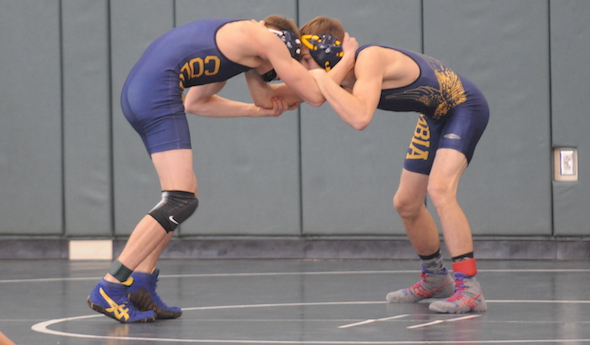
Brooklyn Twins Locked In After Scare
By
Chip Mundy
Special for Second Half
March 2, 2016
By Chip Mundy
Special for Second Half
BROOKLYN – A little more than a year ago, Cooper Gunnells’ greatest dream was thwarted by what turned into a horrible nightmare.
 A sophomore wrestler at Brooklyn Columbia Central at the time, Gunnells dreamed of qualifying for the MHSAA Division 3 Individual Finals at The Palace.
A sophomore wrestler at Brooklyn Columbia Central at the time, Gunnells dreamed of qualifying for the MHSAA Division 3 Individual Finals at The Palace.
He never got the chance in 2015, but he will be there this year as a Regional champion – and his twin brother will be there, too, in the same weight division.
In January of 2015, an illness – paired with a freak wrestling injury – turned into a nearly two-month stay in the hospital that threatened Cooper’s life.
“At first, we thought we’d lose him for a couple of weeks. Then it was, ‘Oh shoot, we’re going to lose him for the year,’ and then it was, ‘He might die.’ It suddenly put everything into perspective. Wrestling just didn’t seem that important anymore.” – Columbia Central wrestling coach Ron Guernsey
Cooper said he had a slight cold early in January, but it didn’t keep him from wrestling as it wasn’t a big deal. However, what happened in one match turned into a very big deal.
“My throat was a little dry because of the cold,” he said. “I got put in a headlock, and I think I went to pry up on this guy’s elbow to get away from him, and I felt a little rip in my throat, but I didn’t think anything of it. I just kept on wrestling.”
As the days went on, Cooper began to have trouble breathing. He noticed it during some of his matches.
“It hit me hard,” he said. “When I was wrestling one kid, I felt very fatigued. I couldn’t get my breath back. I was looking at my coach like, ‘What is going on? I’m not usually like this.’”
It also affected his sleep, and the only way he could get a decent night of sleep was to sit in a chair with his arms folded on the top of the chair to provide a little relief in his lungs.
After two trips to the emergency room – both times he was told he had mononucleosis – things got worse.
“The moment I really started to feel like something was really serious was when I started having shallow breaths and couldn’t really breathe that well,” Cooper said. “My chest really, really hurt; it hurt to the touch.
“I called my dad and told him that something was really wrong; he needed to come get me, and we needed to go to the hospital now. It was like nine or 10 o’clock at night. They hooked me up to an EKG, and they looked at me, then looked at the machine again, and said, ‘You need to get to U of M pronto.’ I didn’t know what was going on.
“All I remember from that point on is they hooked me up to a morphine bag. They started pumping me full of morphine, and I just kind of dozed off to sleep. I was there, but I wasn’t. I remember like little periods of that whole incident.”
The “rip” he had felt in his throat was actually a tear in his esophagus, so when he ate or drank, everything spilled into his lungs and chest cavity, causing an infection.
“If we had waited another day or two, from what the doctor said, the outcome wouldn’t have been very good,” said Cooper’s father, Scott Gunnells.
Cooper was in the intensive care unit as the doctors battled the infection.
“It was just a weird set of circumstances that brought it about,” Guernsey said. “Once it got into his lungs, they had to go in two different times to scrape his lungs.
“It was a big deal. They were pumping him with antibiotics, and he went from 125 pounds to 100 pounds. It was hard to even look at him.”
Cooper’s twin brother, Keenan, had a similar feeling.
“It was really scary,” Keenan said. “I didn’t even want to go to the hospital to see my brother in the condition he was in. It was hard.”
As Cooper lay in the hospital, he really was unaware of his condition or the severity of it.
“At first, when I starting coming to, I was bloated full of fluids and had chest tubes in me,” he said. “I was like, ‘What is going on?’ I had a whole bunch of IVs in my arm. The doctors came in and told me I ripped my esophagus and everything I was eating and drinking was going to my chest cavity. It made this thick mucus inside my lungs, and then the pericardium (sac around your heart), that was full of fluids, too.
“I had tubes going in my neck down into my chest area and tubes from both sides of my chest that was draining out all of the junk that was inside of me.”
He also was incubated with a breathing tube.
“The thought came to my head that I might never wrestle again, but I really wanted to wrestle.” – Cooper Gunnells
When Cooper was first released about six weeks after going into the hospital, he returned after just eight hours and stayed another week.
While in the hospital, his spirits were lifted when the Michigan State University wrestling team sent a signed shirt, and three members of the University of Michigan wrestling team visited him in the hospital.
“That was really cool,” Cooper said. “I asked them about their go-to moves and stuff like that, and they said to ‘stick to the basics.’”
A return to wrestling was going to be a big step for a young man who had dropped 20 percent of his body weight from 125 to 100 pounds, and the doctors put him on a 4,000-calorie diet – maybe the only good thing that happened to Cooper during that time.
“It was great actually,” he said. “I splurged on ice cream and chocolate milk. They had these calorie bags that they would open and pour into my chocolate milk. It’s like 1,000 calories each.”
 Cooper got out of the hospital in time to see his twin brother, Keenan, nearly advance to the MHSAA Tournament. He lost by one point in his final match in the Regional.
Cooper got out of the hospital in time to see his twin brother, Keenan, nearly advance to the MHSAA Tournament. He lost by one point in his final match in the Regional.
During the season, Keenan normally wrestles at a different weight class than Cooper so both can get into the lineup, but that was not necessary when Cooper was sidelined last season. But Keenan felt like he was wrestling for his stricken brother and made some changes to honor him.
“I was wrestling for him for sure,” Keenan said. “He made me try harder. Actually, at two tournaments, I bumped up to his weight class and took first at that level. I did it for him.”
Cooper never lost his desire to get back to wrestling. He returned to the mat near the end of the WAAAM (Wrestling Amateur Athletic Association) season.
“My dad told me I couldn’t wrestle at first,” Cooper said. “He just said, ‘We’ll see where you are in a couple of months.’ It was two weeks before WAAAM ended when I wrestled in WAAAM. I was huffing and puffing; it was hard to breathe.
“Keenan took first in WAAAM and I took eighth, but it was a learning process and had to start somewhere.”
Cooper played on the soccer team last fall to help build up his cardio, and he was relentless in his work to get back in wrestling shape.
“He worked so much harder when he got out of the hospital to get back where he is now,” Keenan said. “Those late-night runs, while I’m sitting on the couch doing cookie curls – eating cookies while he’s out running and busting his butt – just to know where he’s at now, I’m so proud of him.”
Cooper said he feels like he is 100 percent in all areas except endurance.
“I would say I’m 100 percent now strength-wise, but cardio-wise no,” he said. “Those months of being in bed – I couldn’t even walk down the hallway and back.”
Cooper is back. He is seeded first at 125 pounds in Division 2, and he brings in a record of 38-3.
But there remains one unique twist to the story.
“My little brother beat me.” – Keenan Gunnells, on losing to Cooper in the Regional Semifinals two weeks ago
Although Keenan had wrestled at 130 pounds most of the season, he dropped down to 125 for the Regional in an attempt to reach The Palace.
Obviously, that set up the possibility of the twin brothers meeting each other officially for the first time. It was a situation that was tough to face, and it ended up becoming a reality in the Regional Semifinals.
Not everybody wanted the match to take place.
“I told them not to do it,” Scott Gunnells said. “I didn’t want them to wrestle, just flip a coin and save the energy for someone else. Somebody had to lose anyway, and whoever loses has to wrestle harder to get back in.”
Cooper had similar thoughts.
“I really didn’t want to wrestle him because he’s my brother,” he said.
Keenan, who likes to remind Cooper that he is 4 minutes older, was a little more for settling things on the mat.
 “It was hard, but it was fun,” Keenan said. “Coach Guernsey gave us the chance not to wrestle. I could have injury-defaulted out of the match and then dropped back down, but I wanted to take first or second to move on, so why not wrestle for it? Who’s the better wrestler?
“It was hard, but it was fun,” Keenan said. “Coach Guernsey gave us the chance not to wrestle. I could have injury-defaulted out of the match and then dropped back down, but I wanted to take first or second to move on, so why not wrestle for it? Who’s the better wrestler?
“It went to overtime, and he got the last takedown, so my little brother beat me.”
While Cooper went on to win the Regional title, Keenan regrouped and finished third to earn a spot at the Finals with a 38-10 record. And a repeat meeting could happen again.
Both are seeded high, and a rematch could take place in the Semifinals or possibly even the Final. With a championship at stake, the twin brothers have a little different outlook.
“It’s a no-mercy kind of thing,” Cooper said. “That’s what we kind of did at Regionals, but now that we’re in states, we’re going to go at it if we meet.”
Keenan would love to reverse the outcome of the last meeting, but either way, he is really pleased to be there with Cooper.
“It’s kind of neat,” Keenan said. “Say Cooper and me both make it through our brackets, we could meet in the Finals. Twins in the Finals? I’m pretty sure everyone would be watching us and not caring about the other matches that are going on.
“I really wanted to make it to state, but it makes it 10 times better to know that my brother will be there with me on the mat while I’m wrestling.”
“I learned that you can’t take life for granted.” – Cooper Gunnells
Cooper said even he is surprised to be where he is today after the terrible ordeal.
“I would have thought it was going to take way longer for me to recover,” he said. “I was like 101 pounds.”
Scott Gunnells reflects on the past year and remembers the pain and worry. He also said he will never forget the support from the community.
“They had a big spaghetti dinner last year, and people showed up who I didn’t even know,” he said. “The community was great, and the outgiving of the community and the sacrifices of the coaches will always be in my mind.
“I don’t care who wins or loses. They are both coming home and both are going to eat at the same table. It doesn’t matter to me.”
The Gunnells brothers have another year to wrestle in high school, and wrestling in college is something both would like to do.
When asked if he had any colleges in mind, Cooper gave an insightful answer.
“I want to wrestle in college and I am hoping to go to Western Michigan because they have a nursing program,” he said. “After going through everything, I think it would be cool to be able to help people.
“You can’t take life for granted. Going through the ICU and seeing some people who were much worse than me, that was pretty painful, too.”
 Chip Mundy served as sports editor at the Brooklyn Exponent and Albion Recorder from 1980-86, and then as a reporter and later copy editor at the Jackson Citizen-Patriot from 1986-2011. He also co-authored Michigan Sports Trivia. E-mail him at [email protected] with story ideas for Jackson, Washtenaw, Hillsdale, Lenawee and Monroe counties.
Chip Mundy served as sports editor at the Brooklyn Exponent and Albion Recorder from 1980-86, and then as a reporter and later copy editor at the Jackson Citizen-Patriot from 1986-2011. He also co-authored Michigan Sports Trivia. E-mail him at [email protected] with story ideas for Jackson, Washtenaw, Hillsdale, Lenawee and Monroe counties.
PHOTOS: (Top) Brooklyn Columbia Central twins Cooper (left) and Keenan Gunnells wrestle during a Regional Semifinal at Williamston two weekends ago. (Middle) Cooper, below left, Keenan and their coach Ron Guernsey. (Below) Keenan Gunnells faces Alma's Alex Rosas in a third-place match at the Regional. (Top and below photos by HighSchoolSportsScene.com.)
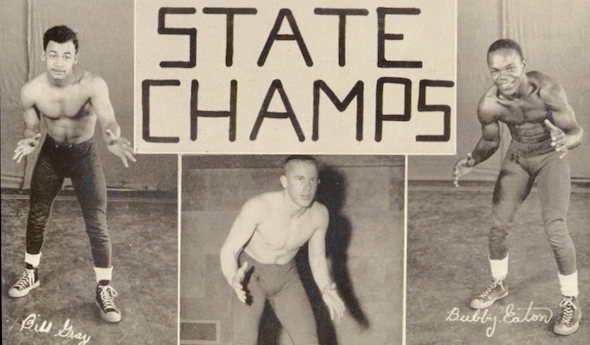
Old 5-A League Fueled Wrestling's Rise
June 29, 2020
By Ron Pesch
Special for Second Half
This latest quest into wrestling began with an inquiry, as these projects often do.
My work with the MHSAA – which includes the title ‘historian’ – is mostly a hobby that began many years ago. The diversion often gets me into press boxes and places the average sports fan doesn’t usually get to venture. Now and then, I get to talk into a microphone. But mostly, it is hours of digging; pouring through scrapbooks, yearbooks and newspapers, old and new, as I search for names, details and stories lost in time. The pursuit sometimes leads to awkward phone calls, e-mails and messages where I try to describe who I am and why I’m chasing a phone number for someone, a person’s mother or father, grandmother or grandfather.
I adore the chase and resolving mysteries. I love visiting libraries and schools and delight in connecting with people. I love filling in holes and connecting dots. I’m a computer guy by trade, focused on analyzing and aligning data. I equate sports searches to detective work, and for fans of old television, I’m like Columbo without the trench coat or cigar, always asking, “Just one more thing …”
Wrestling
My first visit to the sport was in junior high gym class. That’s when Coach Murphy paired me up against another undersized classmate. With the shrill of a whistle, we battled it out on a deep red colored mat – representative of one half of the red and grey school colors of Nelson Junior High. The struggle lasted for no more than a matter of seconds. With a slap of a mat, or perhaps another whistle, it was over. I lost by ‘fall’ – the gentler way of saying I was pinned.
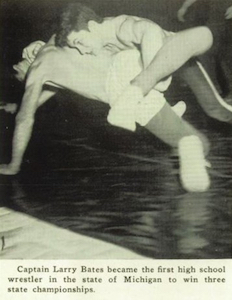 My second visit to the sport came in high school. That’s when the wrestling coach stopped me in the hall one day to suggest I join the wrestling team. Apparently, word of the skills I demonstrated at Nelson hadn’t travelled the half mile east from the junior high to the high school. Quickly recognizing this fact, I told him it might be counter-productive, as I wasn’t much of a wrestler. He was undeterred. Because I was still undersized, he said, I would likely win a fair number of matches. Many schools, it seemed, struggled to find someone to wrestle in the lower classes, and hence, would have to forfeit. I still turned him down.
My second visit to the sport came in high school. That’s when the wrestling coach stopped me in the hall one day to suggest I join the wrestling team. Apparently, word of the skills I demonstrated at Nelson hadn’t travelled the half mile east from the junior high to the high school. Quickly recognizing this fact, I told him it might be counter-productive, as I wasn’t much of a wrestler. He was undeterred. Because I was still undersized, he said, I would likely win a fair number of matches. Many schools, it seemed, struggled to find someone to wrestle in the lower classes, and hence, would have to forfeit. I still turned him down.
I give credit to the Coach Erickson. He was trying to involve a kid in athletics that wasn’t going to make the football, basketball or track team. But that bit of wisdom didn’t hit me until long after high school.
As the above may demonstrate, an extensive understanding of the intricate particulars of wrestling isn’t my strong suit. I’ve attended only one MHSAA Wrestling Final. That visit still remains among my favorite sports sights. The pageantry of the Grand March staged before the orchestrated pandemonium of the MHSAA wrestling championship combined with huge crowds and inspiring athleticism creates a spectacular event.
The Latest Project
Recently, a question, relating to past individual champions from the earliest days of the championships, arrived at the MHSAA office. The Association has awarded wrestling titles since 1948, and a list of team champions and runners-up from the beginning to the present appear on the MHSAA Website. Missing, however, are the names of the individuals who won championships between 1948 and 1960.
To find an answer, that meant a deep dive into newspapers, yearbooks and old wrestling guides to exhume the particulars from articles and agate, cross-referencing results, matching last names to first names, correcting spellings and occasionally schools when obvious errors have been made.
Technology has helped carve away some time and travel when embarking on such a project. Once, the only way to dig out such information was to travel to microfilm, and then spend hours scrolling past print. Today, thanks to some online archives, even during a global pandemic, we can visit a handful of Michigan newspapers via the internet. Tack on the ability to search the online cloud of information, intriguing elements intermittently bubble to the surface, transforming a standing list of names and schools to an account that brings at least some names to life.
The Beginnings
An initial look at the existing team championship listings revealed the first fact. For all intents and purposes, the earliest days of the MHSAA wrestling state championships served as a glorified meet for the members of the 5-A Conference. The league, comprised of Ann Arbor, Battle Creek Central, Jackson, Lansing Eastern and Lansing Sexton high schools, was where wrestling as a prep sport first gained traction in Michigan. Almost immediately, Greater Lansing established a stronghold on the sport that would last those first 13 years.
From 1948 to 1960, there was only one classification in which all schools, regardless of size, competed. In 10 of those 13 years, one of two Lansing high schools – Eastern or Sexton – won the state’s mat championship. In the three years when a Lansing team didn’t win, they finished as runner-up. Those three were part seven total of that baker’s dozen when either Eastern or Sexton finished second.
Growth in Michigan
The first championship tournament in 1948 involved around a dozen schools. While expansion into other schools commenced slowly, by 1957, wrestling had progressed into the fastest growing sport in Michigan.
“The sport blossoms into many new schools every year,” stated George Maskin in a January issue of the Detroit Times in 1957. “Best estimates are that at least 60 varsity prep teams now are in competition. The figure should come close to the 100 mark within a year or two. Prep wrestling has grown with such swiftness it now is necessary to hold regionals to determine qualifiers for the state meet.
“It is not the kind of wrestling one has watched on television or in some of the professional arenas around the state,” he added, trying to educate the public about the difference between the prep sport and the form of broadcast entertainment then popular. “Groans and grunts have no part in high school wrestling … nor does hair pulling or stamping the feet … or pointing a finger into the referee’s eye.”
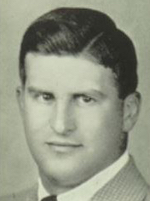 Coaches of wrestling noted that it was one of the few sports offered that gave equal opportunity to students regardless of their physical build. Separated into 12 weight classifications, running from 95 pounds and under up to the unlimited, or heavyweight division, there was a place for all.
Coaches of wrestling noted that it was one of the few sports offered that gave equal opportunity to students regardless of their physical build. Separated into 12 weight classifications, running from 95 pounds and under up to the unlimited, or heavyweight division, there was a place for all.
“Take the kid who weighs 95 pounds,” Ignatius ‘Iggy’ Konrad, a former wrestler at Michigan State and the coach at Lansing Sexton, told Maskin. “He’ll participate against a boy of similar weight. Thus a kid whose athletic possibilities might appear hopeless (in other sports) finds a place for himself in wrestling.”
As the sport continued to expand, coaches were still trying to explain the worth.
“Parents should try to understand the difference between television wrestling and high school and college wrestling,” Grandville coach Kay Hutsell told a Grand Rapids Press reporter in December 1960. “There is no comparison. TV is 100 percent acting.”
A state champion wrestler as a high school student in Illinois, where spectator interest and participation was far greater than in those early days of wrestling in Michigan, Hutsell twice lettered in the sport at Indiana University.
“Wrestling is a conditioner and perhaps develops the body better than any other sport. About the only way wrestling can educate the adults (in the western Michigan area about the sport) is through newspapers.” He felt people should come to “see for themselves.”
The Tournament
Lansing Sexton won the state’s inaugural team wrestling title, 54-43 over the Ann Arbor Pioneers, with the event run off on the mats of the University of Michigan in 1948. Both Floyd Eaton at 127 pounds and Carl Covert at 133 ended the year undefeated for the Big Reds. Five wrestlers from each school earned individual titles that first year. Jackson’s heavyweight, Norm Blank, scored a pin over Sexton’s Dick Buckmaster. The pair had split their two previous matches during league competition.
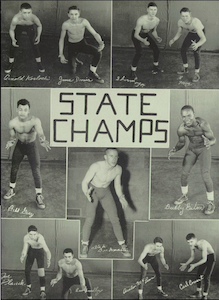 Ann Arbor grabbed the next two MHSAA team titles, both by a mere four points, first 60-56 over Sexton, then topping the Quakers of Lansing Eastern, 56-52, in 1950.
Ann Arbor grabbed the next two MHSAA team titles, both by a mere four points, first 60-56 over Sexton, then topping the Quakers of Lansing Eastern, 56-52, in 1950.
Eight wrestlers qualified for the final round for both Ann Arbor and Sexton in 1949, with five each earning championships. Both schools had three wrestlers finish in third and fourth place; hence the team title was awarded based on Ann Arbor tallying more pins. A total of 96 wrestlers from 11 schools participated in the tournament. Ted Lennox, wrestling at 95 pounds, became the first athlete from the Michigan School for the Blind to compete for an individual title but was defeated by Sexton’s Leo Kosloski. Lennox would later wrestle for Michigan State.
In 1950, nine Ann Arbor wrestlers advanced to the final round with six seizing championship medals, but only Sam Holloway repeated as champion from the previous year. Teammate Jack Townsley, who had won in 1949 at 112 pounds, finished second at 120.
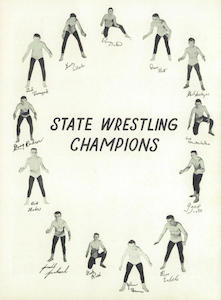 Eastern and coach Don Johnson grabbed the first of two consecutive titles in 1951, topping Ann Arbor, 56-52, with East Lansing finishing a distant third with 26 points. Pete Christ of Battle Creek Central became the first Bearcat (and only the second athlete from a school other than Eastern, Sexton or Ann Arbor) to bring home an individual wrestling title, with a decision over Lansing Eastern’s Vince Malcongi in the 140 classification. “The Bearcat matmen took fourth in the State,” according to the Battle Creek yearbook. “Mr. Donald Cooper took over the coaching duties when Mr. Allen Bush was called to the Marines.” (Bush would later serve as executive director of the MHSAA).
Eastern and coach Don Johnson grabbed the first of two consecutive titles in 1951, topping Ann Arbor, 56-52, with East Lansing finishing a distant third with 26 points. Pete Christ of Battle Creek Central became the first Bearcat (and only the second athlete from a school other than Eastern, Sexton or Ann Arbor) to bring home an individual wrestling title, with a decision over Lansing Eastern’s Vince Malcongi in the 140 classification. “The Bearcat matmen took fourth in the State,” according to the Battle Creek yearbook. “Mr. Donald Cooper took over the coaching duties when Mr. Allen Bush was called to the Marines.” (Bush would later serve as executive director of the MHSAA).
Johnson’s squad absolutely dominated the field in 1952, topping Sexton the next year, 68-43. Ann Arbor followed with 39 points. Seven Quakers – George Smith (95), Herb Austin (103), Jim Sinadinos (127) Bob Ovenhouse (133), Bob Ballard (138), Ed Cary (145) and Norm Thomas (175) – all won their final matches. Both Austin and Sinadinos were repeat champions.
Sexton flipped the table in 1953 with a 67-46 win over Eastern. Ten Big Reds competed for individual state championships among the 12 classifications, with five taking home titles. The Big Reds’ Ken Maidlow, jumping from 165 pounds to 175, and Eastern’s Ed Cary, who moved up to 154, both repeated as medal winners. In the heavyweight class, Sexton’s Ray Reglin downed Steve Zervas from Hazel Park. (Zervas, a two-time runner-up, later wrestled at the University of Michigan, then coached wrestling at Warren Fitzgerald for 34 seasons and served as mayor of Hazel Park from 1974 to 1986).
In 1954, Ossie Elliott of Ypsilanti and Henry Henson of Berkley became the first wrestlers from non 5-A schools to win individual state wrestling titles. Elliott, who had finished as state runner-up in 1953 at 133 pounds, downed Lansing Sexton’s Tom Holden in the same classification. Henson earned a decision over Lansing Eastern’s Ken Bliesener at 154 pounds. Eastern again returned to the winner’s circle, outdistancing Sexton, 60-44. Ypsilanti finished third with 34 points.
By 1955, athletes from 28 high school teams were battling for state team and individual honors on the mats at MSC’s Jenison Field House. As a senior captain, Lansing Eastern’s Larry Bates pinned four out of five opponents in the 112-pound class to become Michigan’s first wrestler to earn three state crowns. Bates grabbed his first title in 1953, competing at 95 pounds, followed by his second in 1954 at 103. Eastern picked up its second-straight team trophy, racking up 102 points on the way to a fourth crown in the eighth year of championships. For the first time, a non-5-A school finished second, as the Ypsilanti Braves grabbed runner-up honors with 84 points.
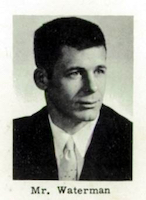 Coach Bert Waterman led Ypsilanti to the first of four championships during a 10-year span in 1956. Two Braves, Ambi Wilbanks and Walt Pipps, earned titles while three others finished second in their classifications. Ypsi had lost one dual meet during the regular season, to Lansing Eastern, by a slim three-point margin. With the 1967-68 school year, Waterman would embark on a 24-year career as coach at Yale University after posting a 192-35-4 mark in 16 seasons at Ypsilanti. A 1950 graduate of Michigan State, the former Spartans wrestler would join Eastern’s Don Johnson, Sexton’s Iggy Konrad, Fran Hetherington from the School for the Blind and two other high school coaches as a charter member of the Michigan Wrestling Hall of Fame in November 1978.
Coach Bert Waterman led Ypsilanti to the first of four championships during a 10-year span in 1956. Two Braves, Ambi Wilbanks and Walt Pipps, earned titles while three others finished second in their classifications. Ypsi had lost one dual meet during the regular season, to Lansing Eastern, by a slim three-point margin. With the 1967-68 school year, Waterman would embark on a 24-year career as coach at Yale University after posting a 192-35-4 mark in 16 seasons at Ypsilanti. A 1950 graduate of Michigan State, the former Spartans wrestler would join Eastern’s Don Johnson, Sexton’s Iggy Konrad, Fran Hetherington from the School for the Blind and two other high school coaches as a charter member of the Michigan Wrestling Hall of Fame in November 1978.
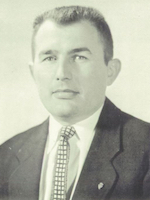 Runner-up in 1956, Eastern grabbed another title in 1957 topping Battle Creek Central, 93-89, in the tournament standings. It was a surprise “going away present” for Coach Don Johnson, who was stepping away after 10 seasons of coaching the Quakers to accept the assistant principal position at Eastern. Battle Creek had five wrestlers advance, and held a 56-48 lead over Eastern as the teams entered the final round. The Quakers’ Ted Hartman opened the day with a victory in the 98-pound weight class, helping Eastern post a 3-1 record in championship round matches. Sexton assisted with the Eastern victory when Norm Young defeated Battle Creek’s Bob McClenney in the 120 weight class. The Bearcats, who had five wrestlers in the finals, ended with two individual champs on the day and their highest finish in their 10 seasons of wrestling.
Runner-up in 1956, Eastern grabbed another title in 1957 topping Battle Creek Central, 93-89, in the tournament standings. It was a surprise “going away present” for Coach Don Johnson, who was stepping away after 10 seasons of coaching the Quakers to accept the assistant principal position at Eastern. Battle Creek had five wrestlers advance, and held a 56-48 lead over Eastern as the teams entered the final round. The Quakers’ Ted Hartman opened the day with a victory in the 98-pound weight class, helping Eastern post a 3-1 record in championship round matches. Sexton assisted with the Eastern victory when Norm Young defeated Battle Creek’s Bob McClenney in the 120 weight class. The Bearcats, who had five wrestlers in the finals, ended with two individual champs on the day and their highest finish in their 10 seasons of wrestling.
An All-American wrestler at Michigan State, Johnson would remain at Eastern throughout his education career, retiring as principal in 1983. The fieldhouse at Eastern was named after him in December 1984, fittingly just prior to the championship round of the annual Eastern High Wrestling Invitational.
Eastern again went back-to-back, topping Sexton, 88-57, with Ypsilanti third in the 1958 championship standings. The meet, culminating with 16 boys competing in each weight division – four each from regionals hosted at Battle Creek, Lansing, Ypsilanti and Berkley – was held at the Intramural Building at the University of Michigan. Both Eastern and Sexton advanced four wrestlers to the final round, with Eastern’s Gary Gogarn (95), Ron Parkinson (145) and Alex Valcanoff (154) earning titles. For Sexton, Fritz Kellerman (133) and Wilkie Hopkins (138) finished on top.
The 1959 championships, hosted at the new intramural building at MSU, found boys from 47 schools chasing medal honors.
“Points toward the team title are awarded one for each bout won, with an extra point for a fall,” noted the Lansing State Journal, explaining the mechanics of the tournament. “The big scoring chance comes (in the final round) with a first place netting 10 points, second 7, third 4 and fourth 2.”
Jackson and Sexton had tied for the 6-A Conference crown (the league renamed with the addition of Kalamazoo Central to the mix) and the race to the MHSAA title was expected to be a tight one. Jackson qualified seven for the semifinal round, with four advancing to the championships. The Big Reds sent five wrestlers to the last round. Vikings Ron Shavers (95), Nate Haehnle (145) and Don Mains (165) had each won matches, while Sexton’s qualifiers Tom Mulder (127) and Emerson Boles (175) had earned titles.
With one match remaining, Jackson trailed Iggy Konrad’s Big Reds by four, 67-63, as the Vikings’ Ed Youngs – the state’s reigning heavyweight champion – squared off with Sexton’s Mickey Devoe. Youngs grabbed a 3-1 decision to repeat, but the Vikings needed a fall in the match for a tie. Hence, the Big Reds eked out a single-point victory, 74-73, to escape with their third state mat title.
The results of the title round of the 1960 tournament, also won by Sexton, telegraphed how far the sport had come. Wrestlers from a dozen high schools squared off for honors in the title matches, with winners representing 10 cities. The Big Reds topped Ypsilanti 70-64, followed by Kalamazoo Central with 56 points. Eight other schools had scored at least 20 points in the tournament; 31 teams had scored at least a point. Tom Mulder of Sexton was the lone repeat champion.
With 112 schools now offering wrestling on their sports menu, the MHSAA split the event into two parts for the 1959-60 school year, with Class A set for the University of Michigan and Class B hosted by Michigan State University. The sport was now in full bloom.
 Ron Pesch has taken an active role in researching the history of MHSAA events since 1985 and began writing for MHSAA Finals programs in 1986, adding additional features and "flashbacks" in 1992. He inherited the title of MHSAA historian from the late Dick Kishpaugh following the 1993-94 school year, and resides in Muskegon. Contact him at [email protected] with ideas for historical articles.
Ron Pesch has taken an active role in researching the history of MHSAA events since 1985 and began writing for MHSAA Finals programs in 1986, adding additional features and "flashbacks" in 1992. He inherited the title of MHSAA historian from the late Dick Kishpaugh following the 1993-94 school year, and resides in Muskegon. Contact him at [email protected] with ideas for historical articles.
PHOTOS: (Top and 4) Lansing Sexton won the first MHSAA Finals in wrestling in 1948. (2) Eastern’s Larry Bates became the first three-time individual champion in MHSAA history in 1955. (3) The Big Reds were led by coach Ignatius Konrad. (5) Lansing Eastern kept the championship in the capital city in 1949. (6) Bert Waterman built one of the state’s top programs at Ypsilanti. (7) Don Johnson was the architect of Eastern’s program.(Photos gathered by Ron Pesch.)

